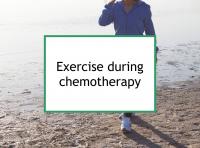Regular exercise or physical activity has been reported to improve breast cancer prognosis in numerous studies. However, there is little information concerning how exercise during neoadjuvant chemotherapy affects tumors. Now a new study has reported that a supervised exercise program improved completion rates but did not reduce tumor size or increase pathologic complete response rates.
Exercise during chemotherapy
Most women reduce their level of physical activity during chemotherapy, commonly reporting muscle weakness and increased fatigue. One study that examined the impact of doxorubicin on the spontaneous physical activity and swimming performance of mice reported a significant decline in the swimming activity of the mice over a 40 minute period. Doxorubicin also significantly reduced the total number of spontaneous movements of the mice during a 24 hour period. The study authors concluded that chemotherapy may significantly decrease the motivation and endurance for physical activity. However, light to moderate exercise has been reported to reduce fatigue, on balance, and may help protect against cardiomyopathy.
Latest research finds exercise has little affect on tumors
The Danish study referenced above described the results of the NEO-TRAIN trial, which was designed to investigate the tumor response to supervised exercise during neoadjuvant chemotherapy. A total of 102 study participants were enrolled between 2021 to 2023 and randomly assigned either to (1) usual care (control group, 52 participants); or (2) supervised high-intensity interval plus resistance training three times per week (exercise group, 50). The trial lasted during 18 to 24 weeks of neoadjuvant chemotherapy, at the end of which participants had surgery to remove their tumors.
The control and exercise groups were compared as to changes in tumor size (the primary outcome), as well as clinical/pathological, biological, physical and patient-reported results (secondary outcomes). No significant differences in tumor size change (i.e., from start of chemotherapy to surgery) were found between the control and exercise groups. The proportion with pathologic complete response or radiologic complete response were also comparable between the two groups. In addition, tumor infiltrating lymphocyte levels (an indication of tumor immune response) were similar.
Regarding the study participants themselves, no differences between the groups were found with respect to body composition, health-related quality of life, and participation in rehabilitation, or factors such as anxiety, depression, and psychological distress. However, those in the exercise group had improved muscle strength, higher levels of physical activity, and increased cardiorespiratory fitness, as well as fewer chemotherapy delays, higher relative dose intensity, and shorter hospital stays. The authors conclude that while the exercise program did not reduce tumor size, it had beneficial effects on chemotherapy completion and reduced hospitalizations, suggesting improved ability to tolerate treatment.
Please see our article on exercise for more information.
